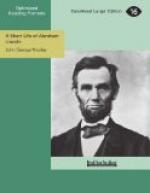The President had early discerned what must become the dominating and decisive lines of advance in gaining and holding military control of the Southern States. Only two days after the battle of Bull Run, he had written a memorandum suggesting three principal objects for the army when reorganized: First, to gather a force to menace Richmond; second, a movement from Cincinnati upon Cumberland Gap and East Tennessee; third, an expedition from Cairo against Memphis. In his eyes, the second of these objectives never lost its importance; and it was in fact substantially adopted by indirection and by necessity in the closing periods of the war. The eastern third of the State of Tennessee remained from the first stubbornly and devotedly loyal to the Union. At an election on June 8, 1861, the people of twenty-nine counties, by more than two to one, voted against joining the Confederacy; and the most rigorous military repression by the orders of Jefferson Davis and Governor Harris was necessary to prevent a general uprising against the rebellion.
The sympathy of the President, even more than that of the whole North, went out warmly to these unfortunate Tennesseeans, and he desired to convert their mountain fastnesses into an impregnable patriotic stronghold. Had his advice been followed, it would have completely severed railroad communication, by way of the Shenandoah valley, Knoxville, and Chattanooga, between Virginia and the Gulf States, accomplishing in the winter of 1861 what was not attained until two years later. Mr. Lincoln urged this in a second memorandum, made late in September; and seeing that the principal objection to it lay in the long and difficult line of land transportation, his message to Congress of December 3, 1861, recommended, as a military measure, the construction of a railroad to connect Cincinnati, by way of Lexington, Kentucky, with that mountain region.
A few days after the message, he personally went to the President’s room in the Capitol building, and calling around him a number of leading senators and representatives, and pointing out on a map before them the East Tennessee region, said to them in substance:




